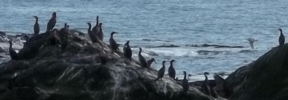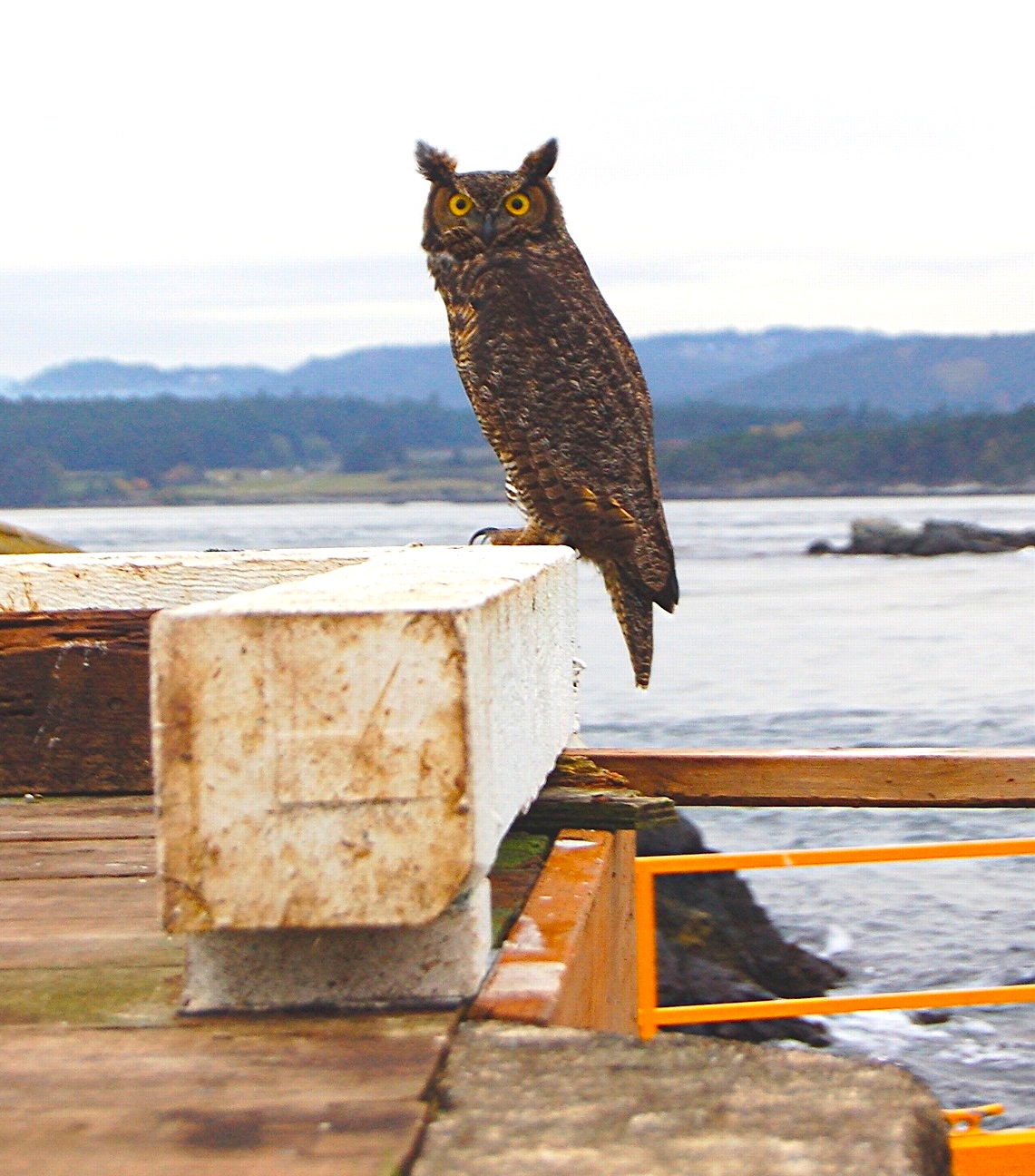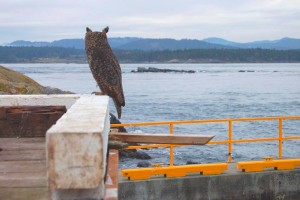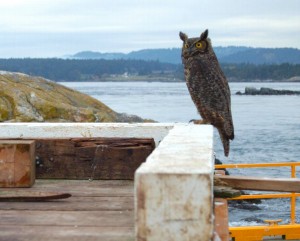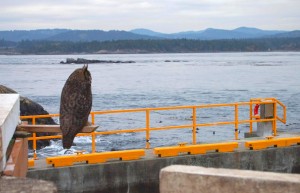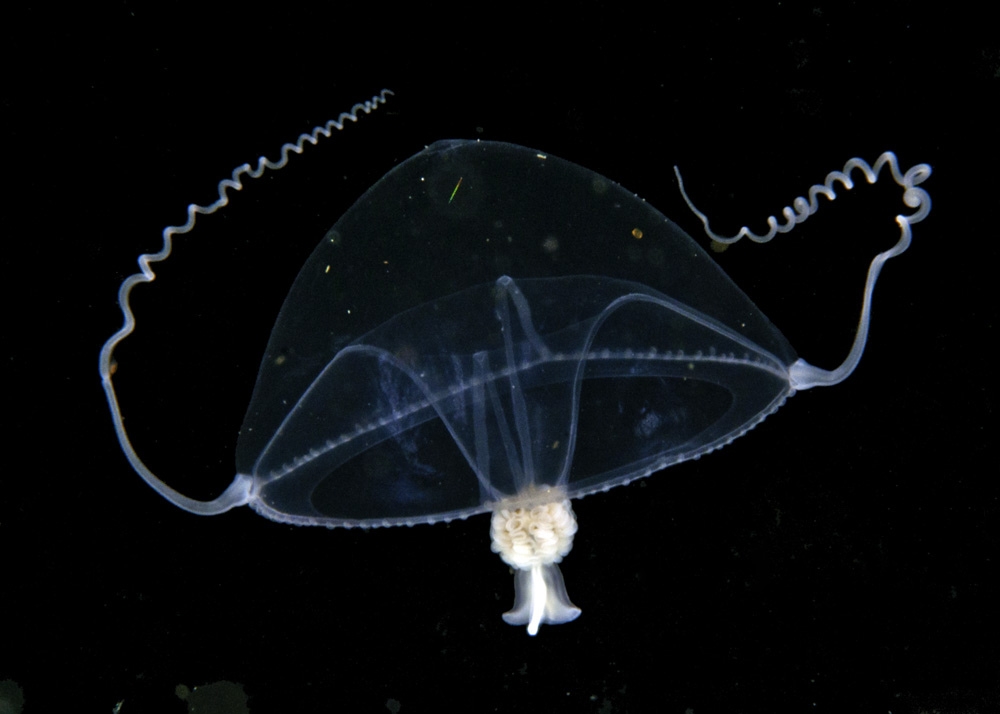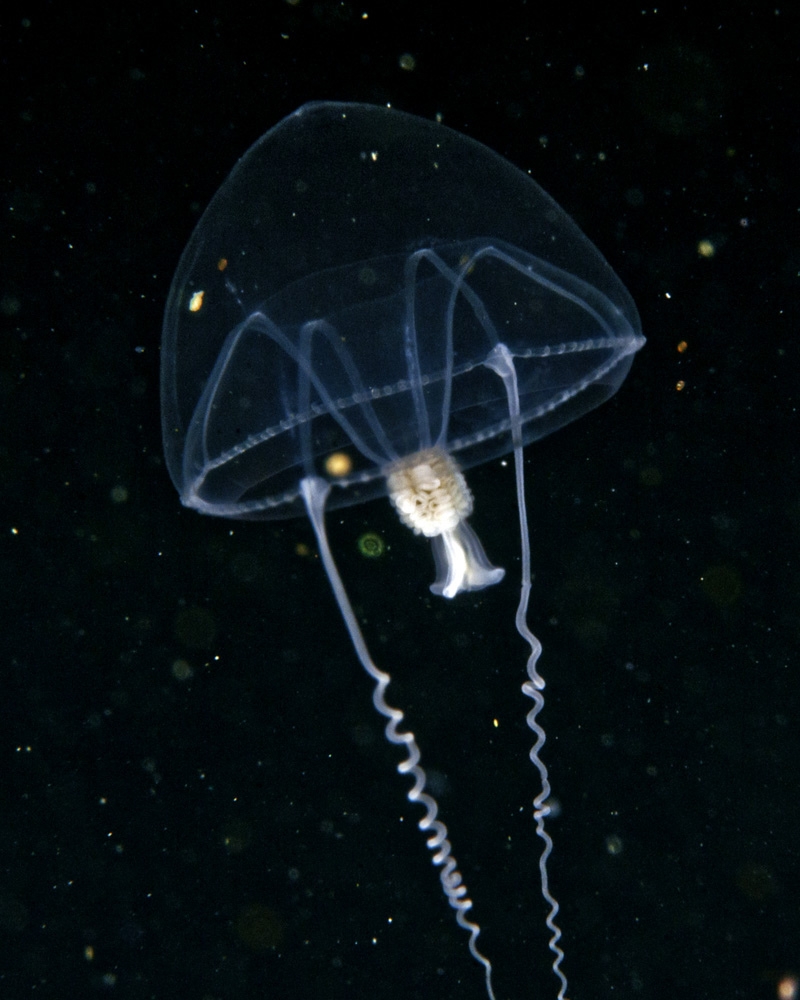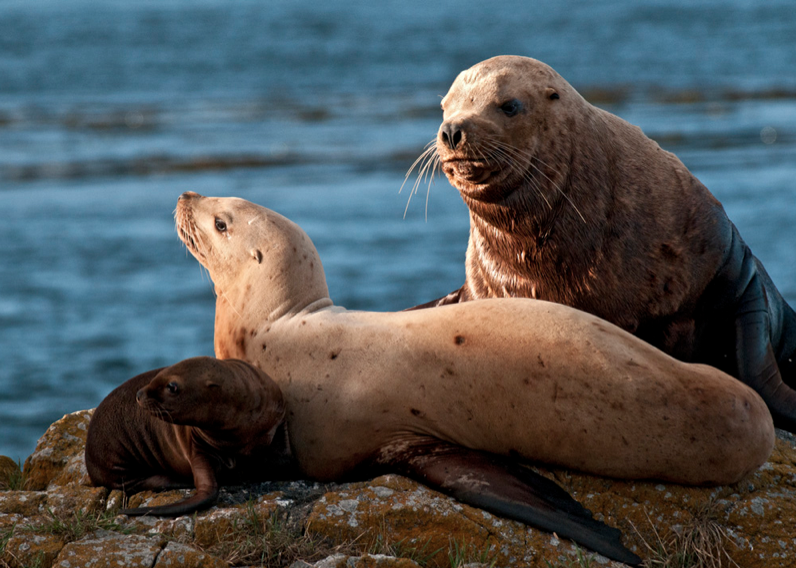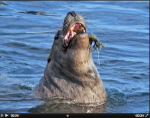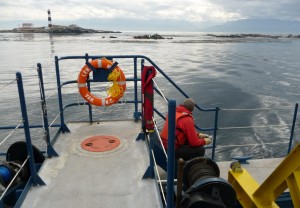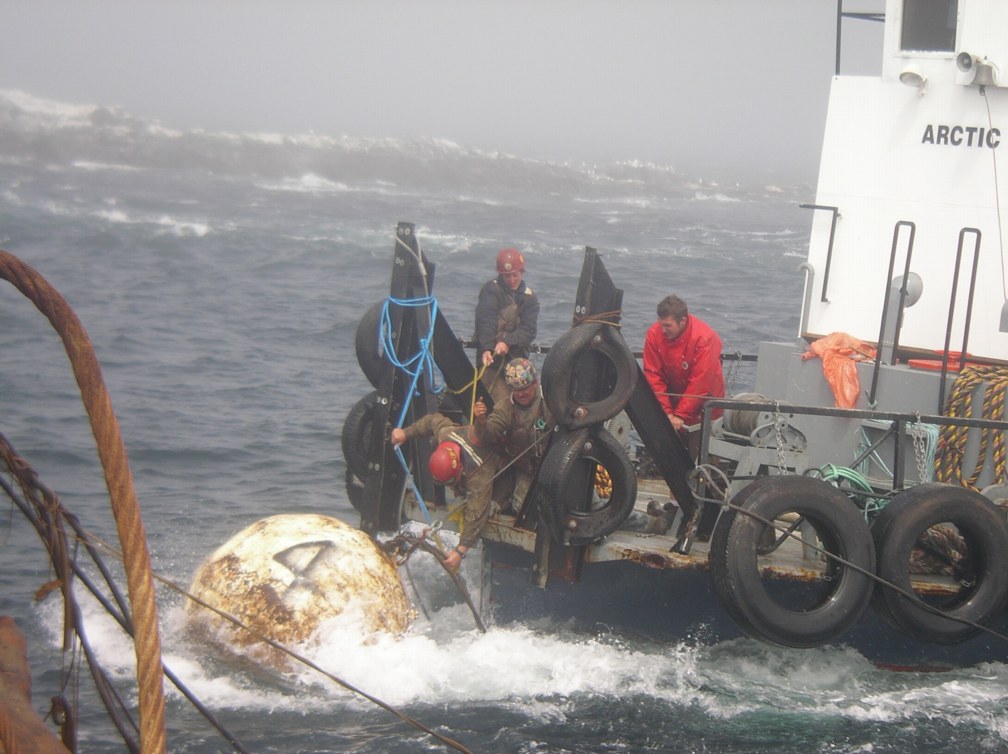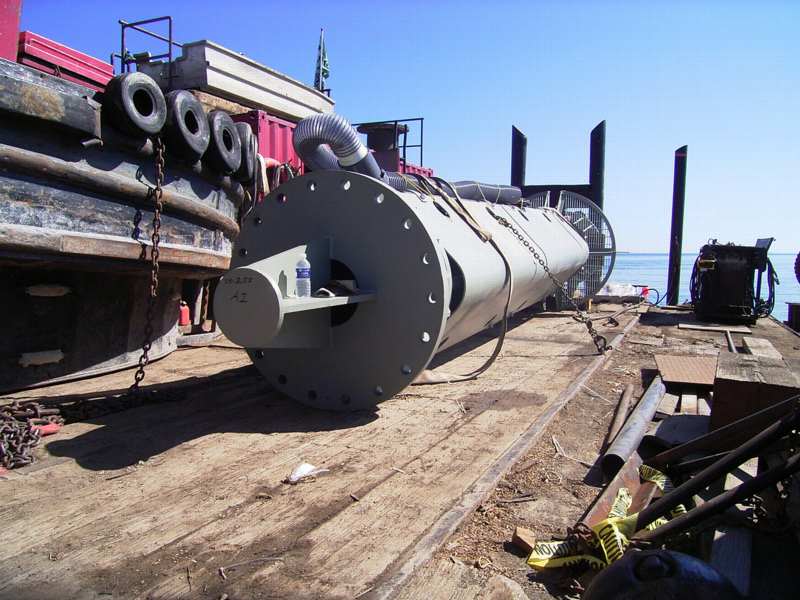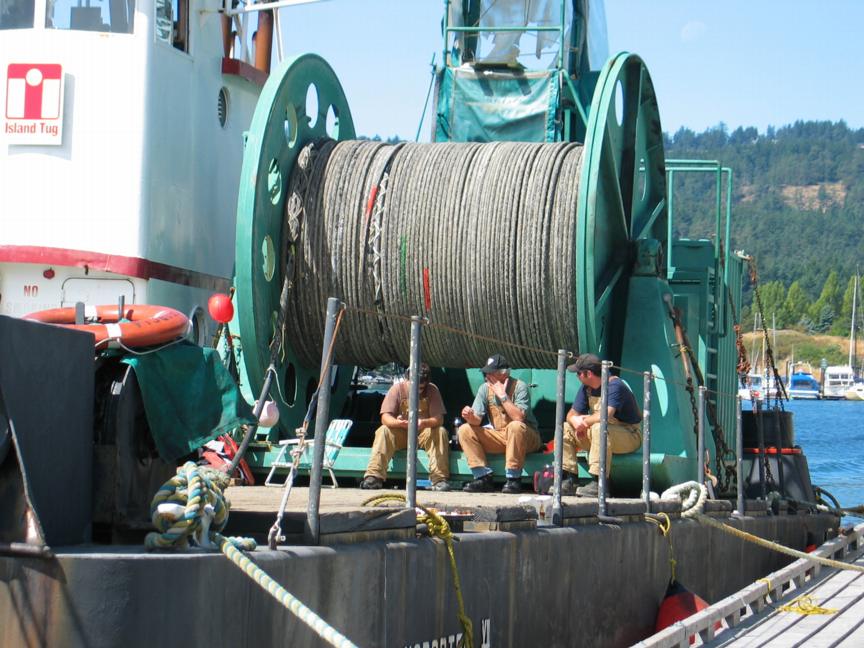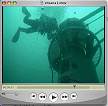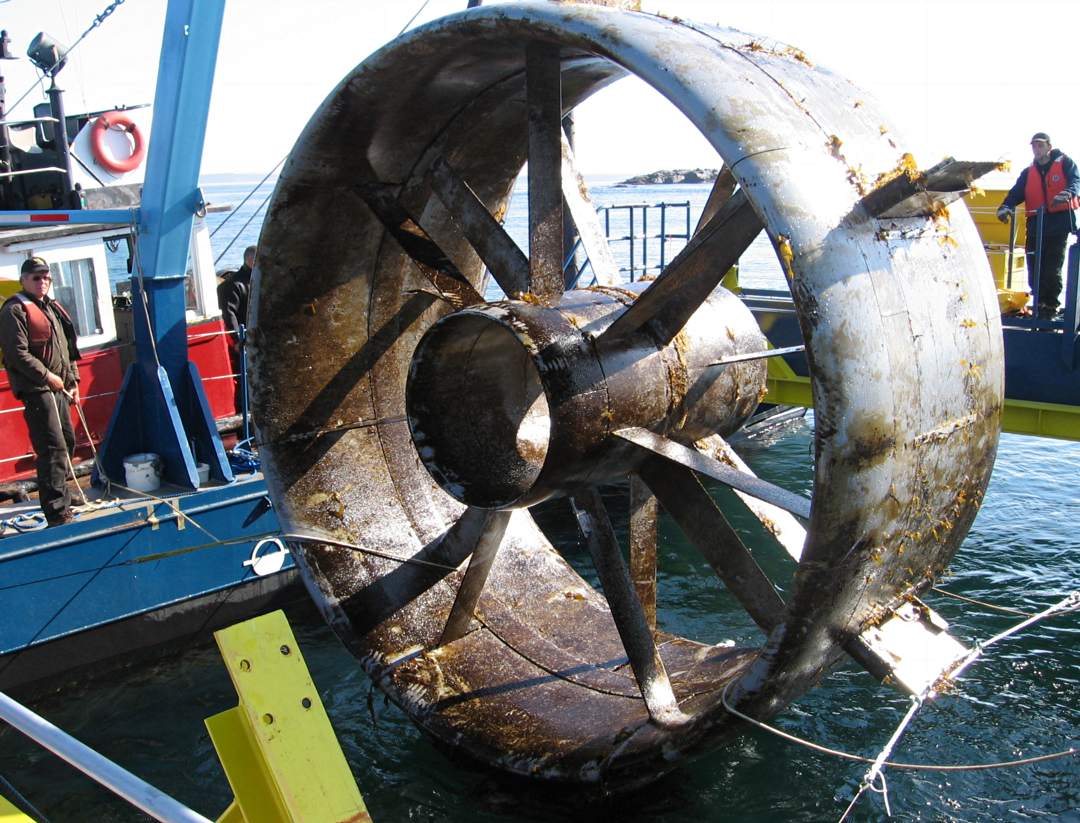Julien and I went out to the island to go over the various mechanical and recording systems on the island with Alex for the purpose of possibly developing an improved electronic data-logging system.
Many large blasts were noted throughout the morning from the DND ordinance disposal pit on Rocky Point. Gulls on South west corner were dispersed on one of the blasts.
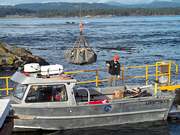 Material to be sent back for recycling was loaded by winch on the boat and Erik and Jake brought us back to the college. They picked us up in the afternoon bringing back the station whaler having undergone repairs over the last few weeks. Erik drove Julien and I in a rather rough return ride in the rigid hull inflatable which has been the substitute boat at the island.
Material to be sent back for recycling was loaded by winch on the boat and Erik and Jake brought us back to the college. They picked us up in the afternoon bringing back the station whaler having undergone repairs over the last few weeks. Erik drove Julien and I in a rather rough return ride in the rigid hull inflatable which has been the substitute boat at the island.
Jake stayed out with Alex to work on the refitting of angle brackets on the solar panels on the roof of the energy building over the next few days. These are intended to increase efficiency by giving more of an angled tilt to the south.
Camera 1 panorama picture was redone to give better ability to click on the panorama image for control of camera.
I noted that a dozen or more of the introduced (non-migratory) strain of Canada geese still persist on the island. Their grazing in the area of the first nations burial cairns remains to be a problem as soil erosion is obvious. I have suggested that we might put up several netted enclosures to document the impact of their grazing.
5 dead immature glaucous -winged gulls were noted on various parts of the island, A full count is pending. This is probably from normal; fall mortality of new birds. On top of the south rocks today, 100 cormorants, probably double crested lined the ridge.
Category Archives: ER Warden Report
Bubo virginianus: Great Horned Owl–The Race Rocks Taxonomy
This great horned owl showed up at Race Rocks on November 12, 2011. There has only been one other reported sighting, on October 14 2006, by members of the Friends of Ecological Reserve field trip . While visiting the island, they saw that an owl had been sitting in a window ledge of the tower, and it flew out when people were going up inside the tower. It was later sighted on the cliff west of the docks, but it flew before they could get a picture.
- Great horned owl photos by Alex Fletcher
- The dorsal side of the owl with its head turned 180 degrees.
Images by Alex Fletcher November 12, 2011
Alex reports that this time it was perched at the upper crane deck platform, and goes in under the crane deck as well. It was still there on November 13. The wind has gusted to 60 km. at Race Rocks on both days, and it has rained frequently during that time.
Domain Eukarya
Kingdom Animalia
Phylum Chordata
Subphylum Vertebrata
Class Aves
Order Strigiformes
Family Strigidae
Genus Bubo
Species virginianus
Common Name: Great Horned Owl
Other owls photographed at Race Rock
and Image File |
 The Race Rocks taxonomy is a collaborative venture originally started with the Biology and Environmental Systems students of Lester Pearson College UWC. It now also has contributions added by Faculty, Staff, Volunteers and Observers on the remote control webcams. Alex Fletcher The Race Rocks taxonomy is a collaborative venture originally started with the Biology and Environmental Systems students of Lester Pearson College UWC. It now also has contributions added by Faculty, Staff, Volunteers and Observers on the remote control webcams. Alex Fletcher |
Stylaster parageus columbiensis- Lindner & Cairns in Cairns & Lindner, 2011
Record in the Smithsonian Institute, from : http://collections.si.edu/search/record/nmnhinvertebratezoology_910698?q=set_name:%22Invertebrate+Zoology%22
Stylaster parageus columbiensis Lindner & Cairns (**in Cairns & Lindner, 2011)
Paratype for Stylaster parageus columbiensis Lindner & Cairns in Cairns & Lindner, 2011
Catalog Number: USNM 1096625
Collection: Smithsonian Institution, National Museum of Natural History, Department of Invertebrate Zoology
- Microhabitat Description:
- shallow water
- Collector:
- Dr. Alberto Lindner
- Ocean/Sea/Gulf:
- North Pacific Ocean
- Preparation: Dry
- Sex: male
- Type Status: Paratype
- Place:
- Strait of Juan de Fuca, Race Rocks near Sooke Community, British Columbia, Canada, North Pacific Ocean
- Collection Date:
- Jul 2002
- Common name:
- Hydrozoans
- Taxonomy:
- Animalia ,
Cnidaria ,
Hydrozoa, - Anthoathecatae
- Stylasteridae
- Published Name:
- Stylaster parageus columbiensis Lindner & Cairns in Cairns & Lindner, 2011
- Stylaster campylecus parageus (Fisher, 1938)
- Stylaster sp.
- Stylaster parageus (Fisher, 1938)
- USNM Number:
- 1096625
- Specimen Count:
- 1
- Site Number:
- AL 470
- Record Last Modified:
- 17 Jul 2013
- See more items in:
- Invertebrate Zoology
- Data Source:
- NMNH – Invertebrate Zoology Dept.
Stomatoca atra: the Race Rocks taxonomy
Ryan Murphy took these pictures of Stomatoca atra underwater at Race Rocks. It was identified by Dr. Anita Brinckmann-Voss.
This file is provided as part of a collaborative effort by the students, faculty, staff and volunteers of Lester B. Pearson College.
See this link for other hydroids: https://www.racerocks.ca/tag/hydroid/
Sea lion juvenile
As Ecological Reserve Warden, I was concerned with the report of continued blasting by the DND given the recent noting of a nursing northern sea lion at Race Rocks. The following is an account of the concern, starting with an e-mail and pictures from the Ecoguardian, Ryan Murphy
Subject “New Development”
Sept 27,2011
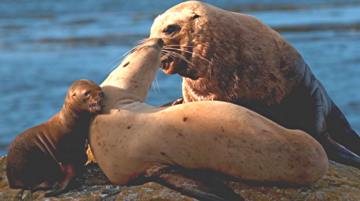 “I’m not sure if the LGL guys noticed this or not… but we have a nursing Steller sea lion pup on Great Race. You’ll see in the photos that the mother is definitely lactating and the pup is nursing on the rock above the jetty (West side). Since Eumetopias jubatus is listed under SARA as Special Concern, I believe this is very significant. DND’s activity at Bentinck Island has not included intervals between blasts to reduce sea lion stampedes, and this pup is definitely at risk of trampling if DND continues their activities as they have for the past 2 days.-
“I’m not sure if the LGL guys noticed this or not… but we have a nursing Steller sea lion pup on Great Race. You’ll see in the photos that the mother is definitely lactating and the pup is nursing on the rock above the jetty (West side). Since Eumetopias jubatus is listed under SARA as Special Concern, I believe this is very significant. DND’s activity at Bentinck Island has not included intervals between blasts to reduce sea lion stampedes, and this pup is definitely at risk of trampling if DND continues their activities as they have for the past 2 days.-
Subject: continued blasting
Date: September 28, 2011 8:30:18 AM PDT
“No need to worry about DND blasting, the landing of LGL personnel and subsequent standing around at the jetty caused a mass stampede with about 50 animals taking to the water including the pup.”
Subject Update
Date: September 28, 2011 9:26:18 AM PDT
“Just so you know, the larger blasts are still coming back to back. I don’t know if LGL communicated the need for increased intervals, but regardless there is no change. The sea lions continued to be disturbed and take to the water with the rapid succession blasts.”
Subject: update
Date: September 28, 2011 4:57:03 PM PDT
“The pup has been back since at least 14:30. I have not seen its mother and it is sporting a fresh 2″ cut on its shoulder. Otherwise looks to be ok, it has been sitting upright trying to stay awake and nodding off as babies will.”
Subject: Re: New development
Date: September 29, 2011 7:04:02 AM PDT
“The pup is still here this morning, the mother is not with it.”
Subject: DND report
Date: September 29, 2011 9:21:24 AM PDT
“As per the log at 9:21 this morning:
Two absolutely massive explosions that shook the house occurred only 10 seconds apart. The glass panes in the windows rattled against their metallic frames. At least 70 sea lions stampeded into the water, completely clearing out entire haul out areas. About 20 sea lions stampeded through the area where the Steller pup was resting.”
As a result of this account of events, I sent an e-mail to BC Parks and DND administration stating the following:
From: Garry Fletcher
Sent: Thursday, September 29, 2011 10:20 AM
Subject: Fwd: New development
I was very concerned to receive the following reports and images from Ryan Murphy our Guardian at Race Rocks. I think it warrants a followup considering the concerns we have for marine mammals being disturbed by human activities, especially those which are SARA listed.
Surely they have enough data by now to show that the window for doing this blasting program might perhaps be reconsidered. We would appreciate hearing of any followup .
FOLLOWUP: So far ( November, 2011) there has been none. The juvenile and mother were not seen again, research by LGL (LGL who are referred to are the DND contracted research group who is at the island again this year to make observations on the effects of detonations at Bentinck Island.) The disturbance to animals by DND blasting continued unabated over the next few days. Their previous reports up to 2010 are included here. The report for this year will be added here when it is available.
Eumetopias jubatus , The Northern Sealion : The Race Rocks taxonomy
I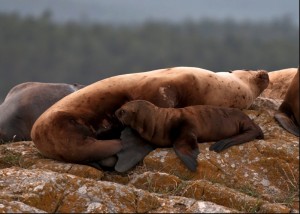 n the fall of 2011, a female northern sea lion (Steller) and her pup appeared at Race Rocks. This is the first such pair that we have seen there. Link to Ryan Muphy’s Flickr site for a set of pictures of the sealions at Race Rocks.
n the fall of 2011, a female northern sea lion (Steller) and her pup appeared at Race Rocks. This is the first such pair that we have seen there. Link to Ryan Muphy’s Flickr site for a set of pictures of the sealions at Race Rocks. 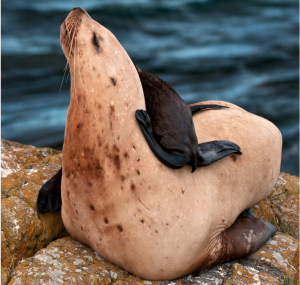 Ryan captured some excellent pictures but noted that due to blasting by the DND on the neighbouring Bentinck Island, the pup was injured and the mother disappeared. See below.. Commentary here is by Ryan Murphy : “Steller or Northern sea lions (Eumetopias jubatus) are the largest sea lion species in the world and are listed under Canada’s SARA (Species at Risk Act) as Special Concern.”
Ryan captured some excellent pictures but noted that due to blasting by the DND on the neighbouring Bentinck Island, the pup was injured and the mother disappeared. See below.. Commentary here is by Ryan Murphy : “Steller or Northern sea lions (Eumetopias jubatus) are the largest sea lion species in the world and are listed under Canada’s SARA (Species at Risk Act) as Special Concern.” 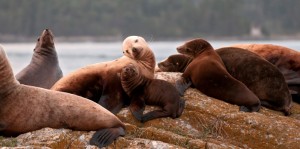 “The Race Rocks archipelago south of Vancouver Island has long been a haul out for Steller sea lions, and we know from Lightkeeper Kurt Cehak’s accounts from the 60s that these marine mammals came to Race Rocks even when locals were encouraged to kill them to collect bounties. “
“The Race Rocks archipelago south of Vancouver Island has long been a haul out for Steller sea lions, and we know from Lightkeeper Kurt Cehak’s accounts from the 60s that these marine mammals came to Race Rocks even when locals were encouraged to kill them to collect bounties. “  “Today, Steller sea lions are a year-round attraction for a multi-million dollar ecotour industry based in the Capital Region District of Victoria, BC. With the arrival of this pup and its mother to Race Rocks, the Ecological Reserve now protects the reproductive ecology of this threatened species.”
“Today, Steller sea lions are a year-round attraction for a multi-million dollar ecotour industry based in the Capital Region District of Victoria, BC. With the arrival of this pup and its mother to Race Rocks, the Ecological Reserve now protects the reproductive ecology of this threatened species.” 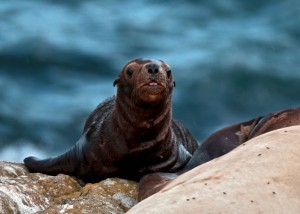 “However, this pup is at risk because of activities of the Canadian Department of National Defence. The island in the background is Bentinck Island and it is used by the Canadian military to dispose of ordinances and explosives training. Their rapid succession blasting during the last two days has caused
“However, this pup is at risk because of activities of the Canadian Department of National Defence. The island in the background is Bentinck Island and it is used by the Canadian military to dispose of ordinances and explosives training. Their rapid succession blasting during the last two days has caused 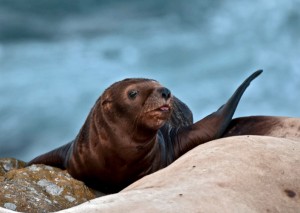 repeated stampedes of sea lions and this pup may be crushed tomorrow.” See the logs on this website posted by the ecoguardians which include mammal census and observations of sealions. Northern Sea lion VIDEOS:
repeated stampedes of sea lions and this pup may be crushed tomorrow.” See the logs on this website posted by the ecoguardians which include mammal census and observations of sealions. Northern Sea lion VIDEOS:
 |
 |
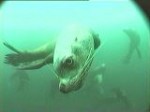 |
||
| EFFECTS OF DND BLASTING at Bentinck Island | Sea lion disruption on middle island by DND blasting |
|
||
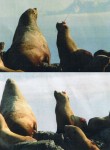 |
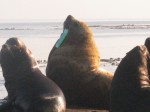 |
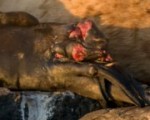 |
||
| Tracking devices on sea lions | This Northern Sea Lion was photographed with fishing equipment swallowed in September 2003..also see other photos of flashers and boat collisions. | This link shows the conflict of motor boats and marine mammals in the reserve. |
Posts on Entanglement of Sea lions in fishing gear
| Domain | Eukarya |
| Kingdom | Animalia |
| Phylum | Chordata |
| Sub Phylum | Vertebrata |
| Class | Mammalia |
| Order | Carnivora |
| Family | Otariidae |
| Genus | Eumetopias (Gill, 1866) |
| Species | jubatus (Schreber,1776) |
| Common Name | Northern or Steller Sea Lion |
 |
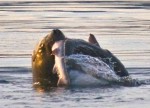 |
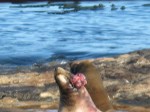 |
| Entanglement of a sealion on Middle rocks and video of release by Vancouver aquarium and DFO personnel | White sturgeon images This is a link to the white sturgeon file where images taken by Ryan Murphy show predation by a Northern Sea lion on a white sturgeon at Race Rocks. | In early November 2007, Mike Slater took this picture of a Northern Sea lion with a large tumor like growth on the side of its face. The animal was not sighted again at Race Rocks, however on August 22, 2009 it was photographed at Mittlenatch Island. |
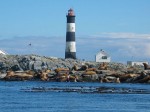 |
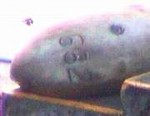 |
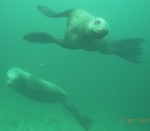 |
| Northern Sea lions peak in numbers in the fall. | Branded Sea lions at Race Rocks : | Sea lions underwater, photo by PC Diver Natan. |
This is the largest of the Otariidae or ‘eared seals’ family.
Habitat: Northern Sea Lions are found on North-Pacific coasts; in Russia, Alaska, Japan, Canada and the USA in particular. They spend most of their time on rocky shores and in coastal water. During bad weather they stay under water. At Race Rocks , the peak in numbers of these mammals is in October to January , upwards of 400 may be reported at Race Rocks. They mix freely with the Californian Sea Lion which may number well over 1000 individuals between October and February.
See the references on Sea Lions in our RREO Index
Description: The Sea Lions at Race Rocks are mainly bachelor bulls or juvenile yearlings. Since this is not a breeding colony, mature females do not usually come here. There are clear differences between males and females. The males are larger in size and weigh more. Whereas the average sea lion male weighs 566 kg (1,245 pounds) the average female weights only 263 kg (579 pounds). Moreover, the average male has a body length of 288 cm (10 2/3 feet) while the average female has a body length of 228 cm (8 2/3 feet). Most females are yellowish or creamed color and most males are dark.
The average life span of a Steller sea lion is about 20 years for males and old females can even reach 30 years. The breeding season is between May-June and each mating produces a single pup.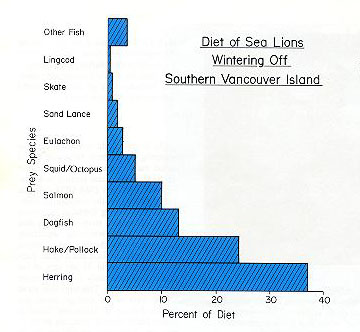 Steller sea lions are marine carnivores. They feed on wild fish (salmon, herring, rockfish, flounder, and Pollock) as well as on invertebrates such as squid and octopus. The Steller sea lions feed at night, usually about 15-20 km. from shore. This relatively selective diet is one of the causes of the sea lions’ decreasing numbers since they compete with humans for this food.
Steller sea lions are marine carnivores. They feed on wild fish (salmon, herring, rockfish, flounder, and Pollock) as well as on invertebrates such as squid and octopus. The Steller sea lions feed at night, usually about 15-20 km. from shore. This relatively selective diet is one of the causes of the sea lions’ decreasing numbers since they compete with humans for this food.
An Eastern Alaskan population is now on the endangered species list due to severe declines in numbers over the past decade. They are now a threatened species included in the ‘Red List’ and protected in the USA and by the Commonwealth Independent States ( CIS).
Although they dive and spent s lot of time under water, Northern Sea Lions are also known for their ‘sunbaths’ and are often watched catching sunlight on the rocky shores. Male Northern Sea Lions are generally aggressive and territorial.
References cited Dec. 2001.
http://www.wc.adfg.state.ak.us/index.cfm?adfg=wildlife_news.view_article&issue_id=40&articles_id=229
See also:
The stellar sea lion: Two distinct stocks, Thomas Louglin, NMML
Other Members of the Class Mammalia at Race Rocks.
and Image File |
 The Race Rocks taxonomy is a collaborative venture originally started with the Biology and Environmental Systems students of Lester Pearson College UWC. It now also has contributions added by Faculty, Staff, Volunteers and Observers on the remote control webcams. The Race Rocks taxonomy is a collaborative venture originally started with the Biology and Environmental Systems students of Lester Pearson College UWC. It now also has contributions added by Faculty, Staff, Volunteers and Observers on the remote control webcams.Dec 2001-Nufar. |
Tidal Energy Turbine Removal
September 17, 2011: Clean Current Staff and diving contractors return to remove the generator for the last time. The generator returns to Vancouver for a final analysis of structural details after exposure in the ocean over the last three years . After cleaning it is to be sent to the Museum of Science and technology in Ottawa, since it was the first ocean tidal generator to be built and deployed in Canada.
The process of removal starts with the barge Lena Marie positioned above the turbine waiting for slack water.
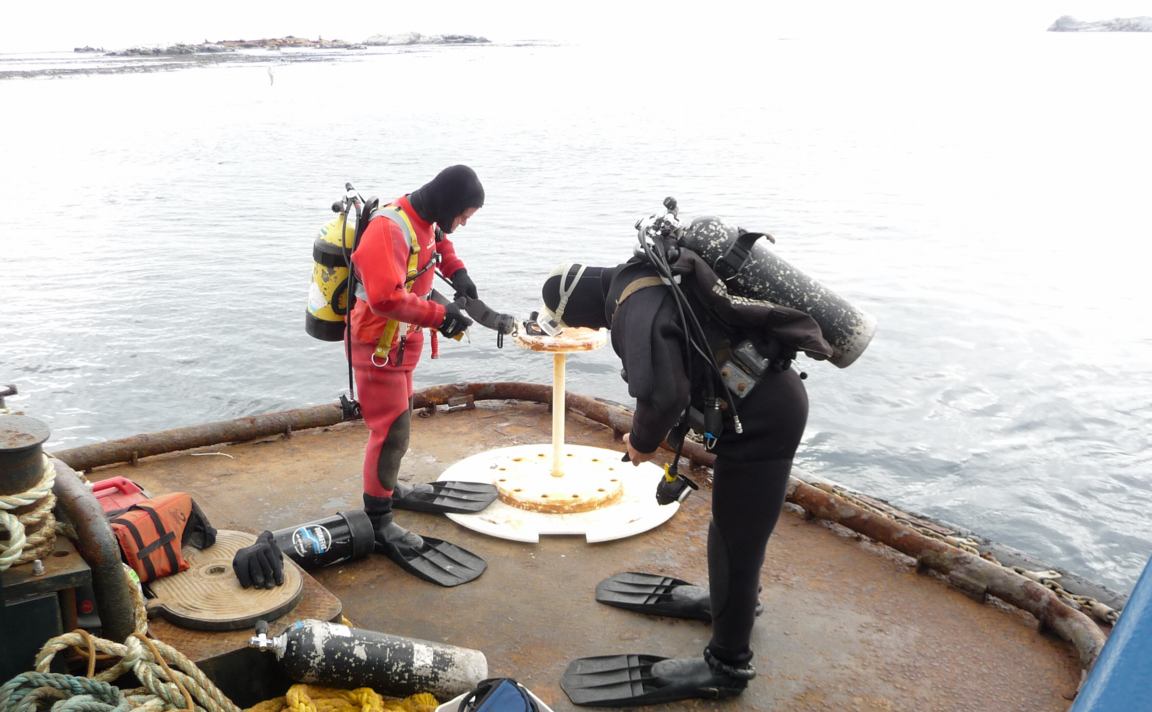 |
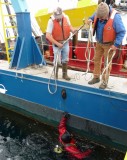 |
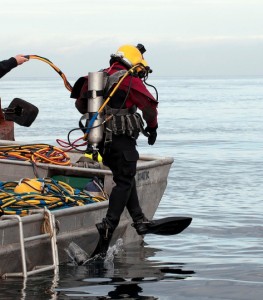 |
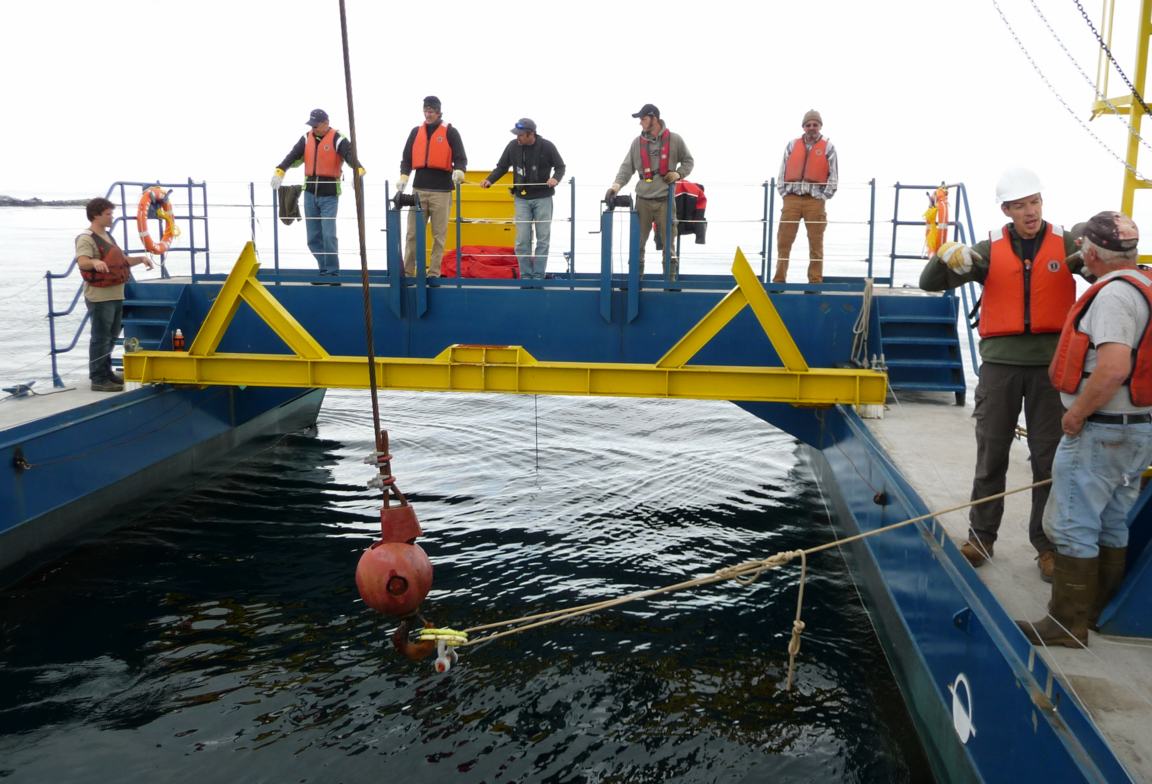 |
| Divers prepare for descending to make preparations for lifting the generator | Passing lines to the divers to stabilize the turbine for lifting | A hard hat diver was deployed to remove the bolts fastening the generator to the piling.( RM photo) | The crew waits on board the Lena Marie as the winch hook is lowered for attachment. |
 |
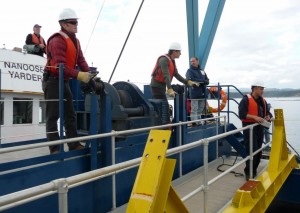 |
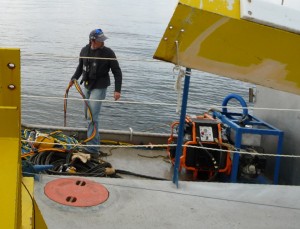 |
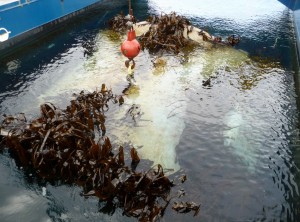 |
| First signs of the generator subsurface. | Clean Current staff controlling the lifting. | Chris Blondeau tending the hard hat diver. | The generator breaks the surface |
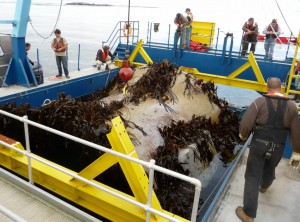 |
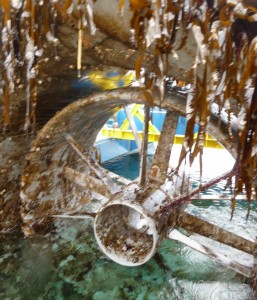 |
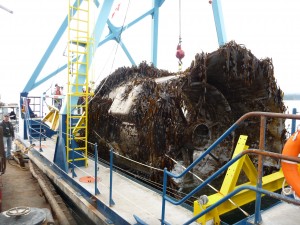 |
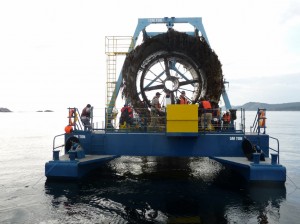 |
| As it emerges, the fouling organisms from the last three years appear. | View of the turbine as the tidal generator comes out of the water. | The predominant macroalgae covering the structure was Laminaria groenlandica. | Lifting operation complete |
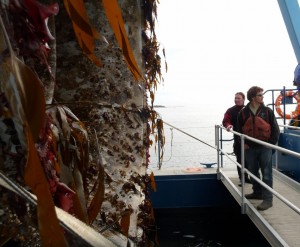 |
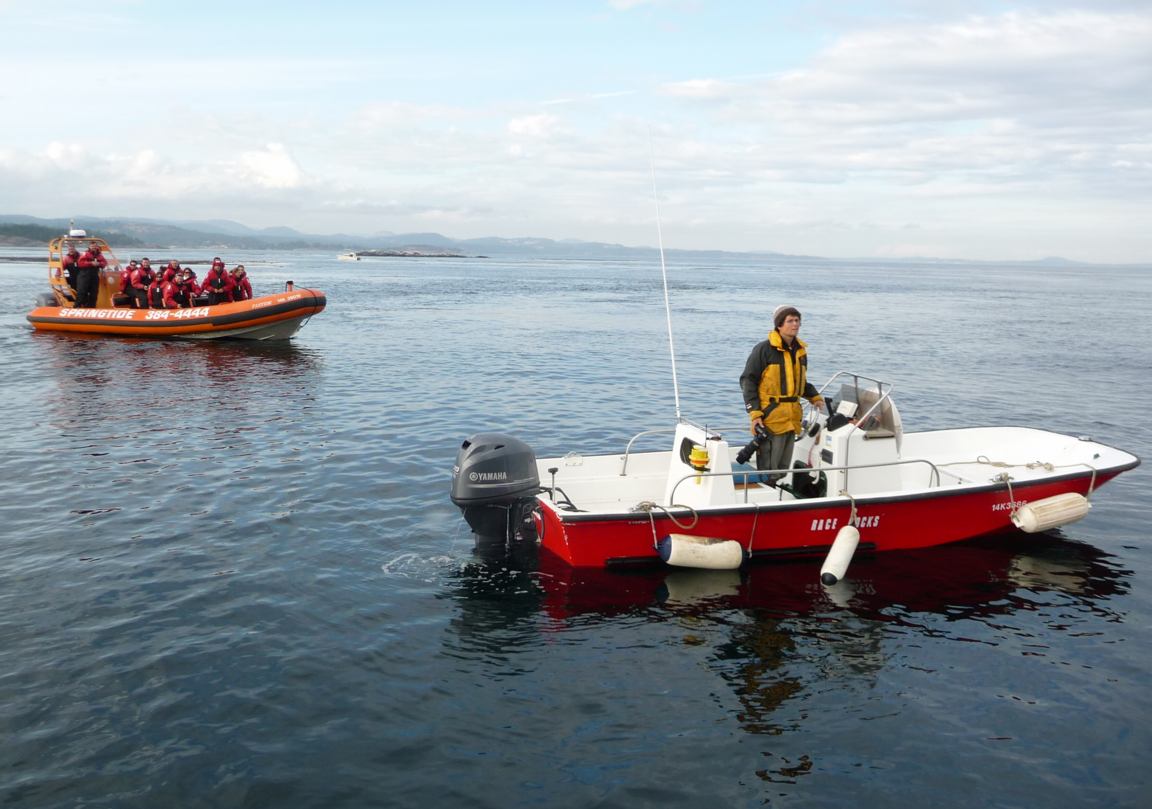 |
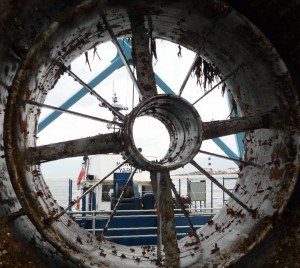 |
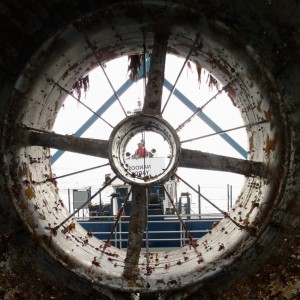 |
| Several red algaes also grow on the structure. | Ryan in the station boat and some curious whale watchers. | Race Rocks through the generator as it heads back to Pearson College. | Tug operator Bruce Davidson seen through the central hole of the generator. |
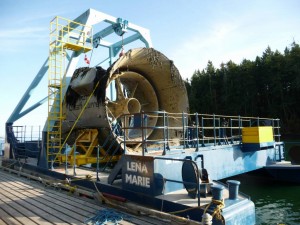 |
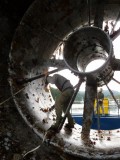 |
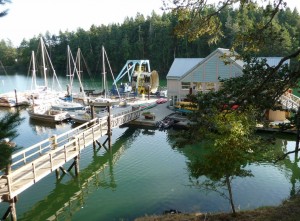 |
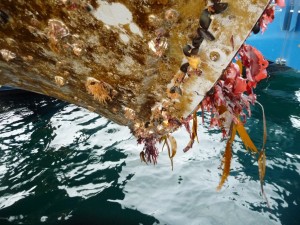 |
| Moored back at the college awaiting transfer to Vancouver. | Erik fastens straps to secure the blades for transport. | Lester Pearson College docks with the generator docked alongside. | Some images of the fouling organisms, part of the ecological succession on the turbine. |
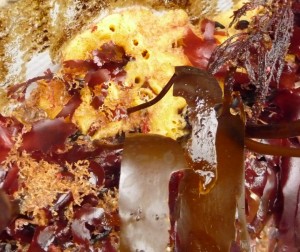 |
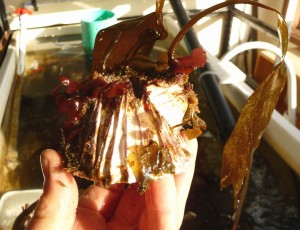 |
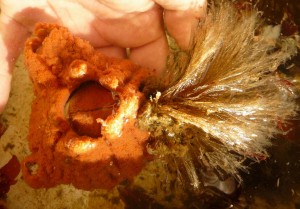 |
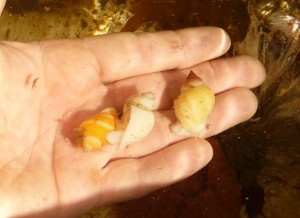 |
| A yellow sponge, probably Mycale toparoki | Very large barnacles that were not Balanus nubilus, but perhaps Semibalanus carriosus were common on the surface. | A unique encrustation of hydroids on a single barnacle. Samples of the many hydroid species were taken by Garry for further identification in the lab. | Interesting colour morphs of Nucella canaliculata
Images by Garry Fletcher |
n conclusion: The Tidal Current Generator operation over the past six years has been an interesting experiment and a good demonstration of the potential power from tidal energy. The value to the Race Rocks program has been largely in the infrastructure that has been developed and installed and the potential for further research. The provision now of most of the energy needs by solar power was only made possible by the large bank of storage batteries provided by the project, the island energy building electrical infrastructure and the partnership with the BC Ministry of Mines and energy which were instrumental in providing the initial solar panels.
Only one student project was developed as a result of the turbine, and this was an analysis of an experiment by Clean Current of the power generation capacity of the generator by Connor Scheu and Wouter Zwart in 2009. In that report, the advantages of the exercise to the company are indicated.
However, due to problems with fibre optic cable malfunctioning and electrical cable leakage, the ability of the generator operate continuously and to provide significant power for the Integrated Energy system at Race Rocks was very limited. It did serve as an adequate base for testing structural materials, and Clean Current provided ongoing support to the Race Rocks program while the turbine was installed.
Garry Fletcher, Race Rocks Ecological Reserve warden
Tidal Current Energy Experiment Comes to an End.
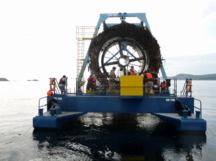 September 17, 2011: Clean Current Staff and diving contractors return to Race Rocks to remove the generator for the last time. The generator returns to Vancouver for a final analysis of structural details after exposure in the ocean over the last three years . After cleaning, it is to be sent to the Museum of Science and Technology in Ottawa, since it was the first ocean tidal generator to be built and deployed in Canada.
September 17, 2011: Clean Current Staff and diving contractors return to Race Rocks to remove the generator for the last time. The generator returns to Vancouver for a final analysis of structural details after exposure in the ocean over the last three years . After cleaning, it is to be sent to the Museum of Science and Technology in Ottawa, since it was the first ocean tidal generator to be built and deployed in Canada.
“In conclusion: The Tidal Current Generator operation over the past six years has been an interesting experiment and a good demonstration of the potential power from tidal energy. The added value to the availability of energy for Race Rocks was however very disappointing.
The main value to the Race Rocks program has been in the infrastructure that has been developed and installed and the potential for further research. The provision now of most of the energy needs by solar power was only made possible by the large bank of storage batteries provided by the project, the island energy building electrical infrastructure and the partnership with the BC Ministry of Mines and energy which were instrumental in providing the initial solar panels. Installation of further solar panels and upgrades by Lester Pearson College UWC has helped to ensure energy sustainability for Race Rocks.
–Garry Fletcher
Tidal Current Energy Project at Race Rocks 2006-2011
Background of the Integrated Energy Project for Race Rocks:
Starting in 1997, Lester B. Pearson College had to raise the funds to keep the diesel generators working to supply electricity to the island. The cost of doing this was originally $11,000 per year and within 4 years reached $20,000. The lighthouse light and foghorn had been made energy self- sufficient with 8 solar panels and a battery array installed by the Coast Guard by 1997. By 1998 we were proposing to develop support for alternate energy technologies to make the rest of the island energy-self sufficient and in so doing, create a curriculum resource on alternate energy for science courses at Lester Pearson College and elsewhere.
The Tidal Current Energy Project which was part of the Integrated Energy Transition at Race Rocks operated from 2006 to 2011. It was essentially a big experiment, and was one that showed the difficulties encountered in working with Tidal Energy installations, while providing the leverage to help Race Rocks transition from fossil fuels to environmentally sustainable forms of energy in operation of a remote educational facility.
This archive provides a chronological account of the process we at Lester Pearson College undertook in this endeavour.
History and Background Information on the Alternate Energy Project at Race Rocks.
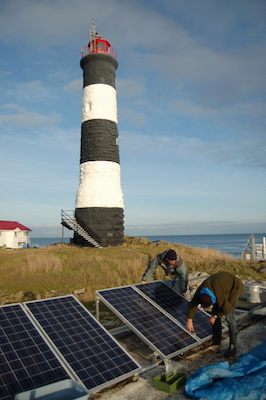 Along with the Tidal energy part of the project , there was also the Solar energy component. It is profiled here: The Solar Energy Component of the Integrated Energy project
Along with the Tidal energy part of the project , there was also the Solar energy component. It is profiled here: The Solar Energy Component of the Integrated Energy project
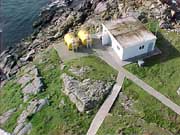 Traditional Energy Generation
Traditional Energy Generation
By Diesel Oil at Race Rocks .Environmental Impacts of the Existing Diesel Powered Generator
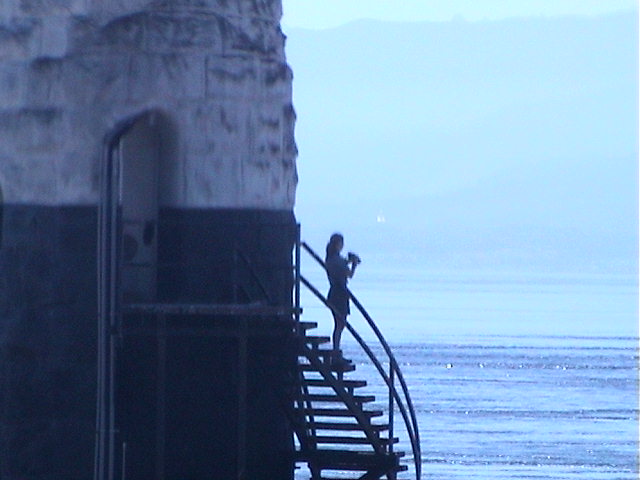 Environmental protection of the Ecological Reserve with the Installation of the Tidal current Generator at Race Rocks..2004
Environmental protection of the Ecological Reserve with the Installation of the Tidal current Generator at Race Rocks..2004
BC Parks Use Permit for the tidal energy project..2004
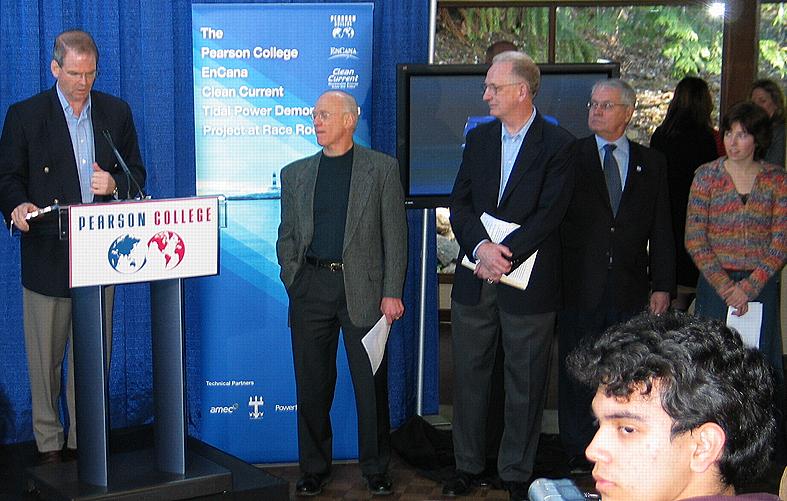
ENCANA Partners to enable Pearson College- ENCANA – Clean Current Tidal Power Demonstration Project at Race Rocks Feb 25, 2005
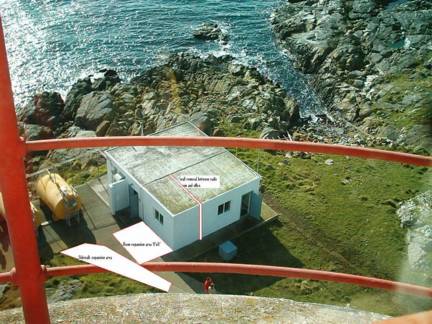 Preliminary Environmental Screening for building of Battery Storage facility May 2005
Preliminary Environmental Screening for building of Battery Storage facility May 2005
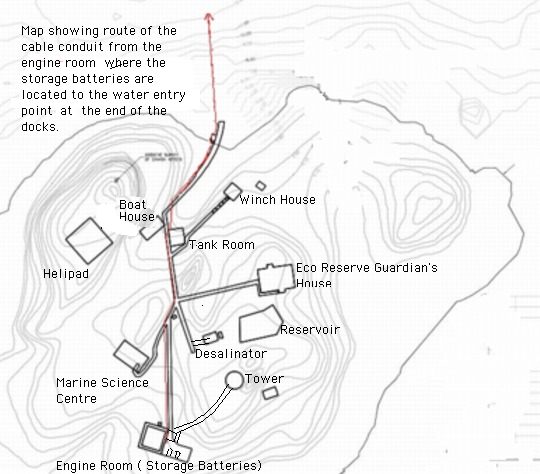 BC Parks Preliminary Assessment for Cable entry and crossing of the island May 2005
BC Parks Preliminary Assessment for Cable entry and crossing of the island May 2005
U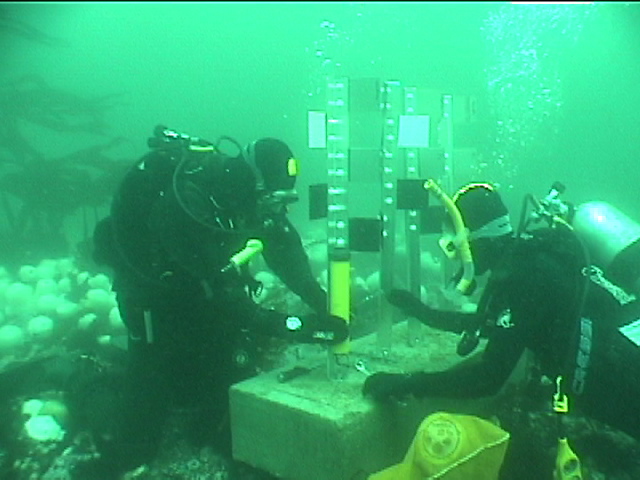 nderwater testing of structural materials to be used for the turbine
nderwater testing of structural materials to be used for the turbine
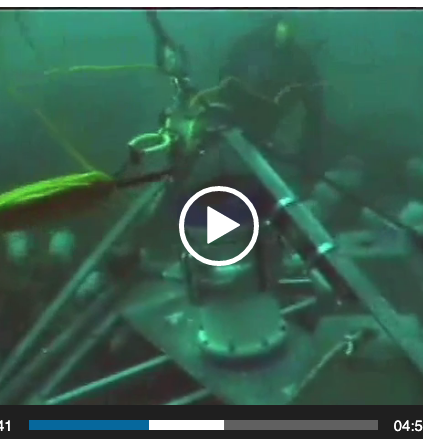 Deployment and retrieval of the ADCP instrument for Current measurement 2005
Deployment and retrieval of the ADCP instrument for Current measurement 2005
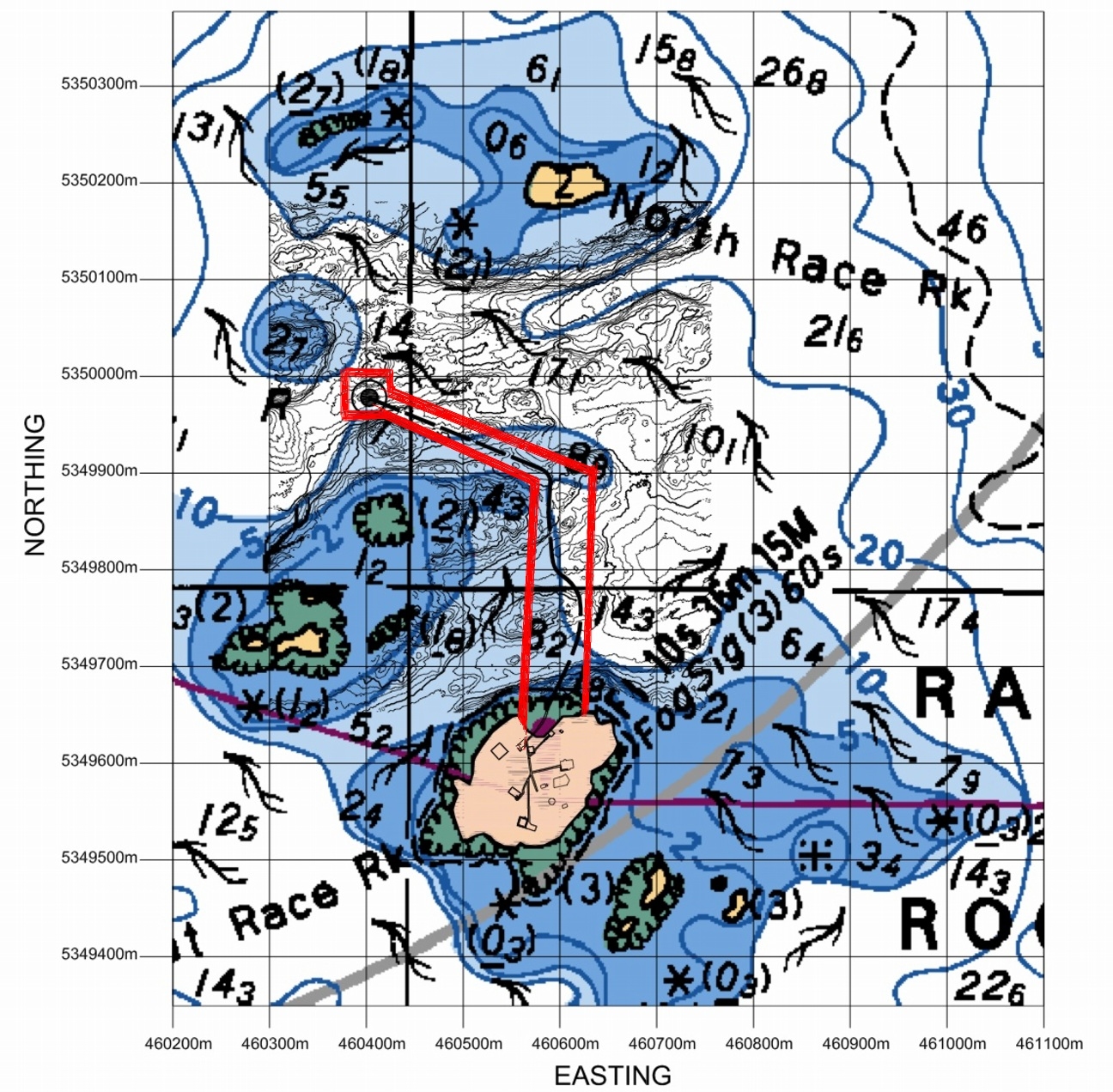 BC Parks Impact Assessment Process for Piling Location , Nov2 2005
BC Parks Impact Assessment Process for Piling Location , Nov2 2005
Nov 2 2005
 Video of Invertebrates on the substrate at Tidal Current Energy site March 2006
Video of Invertebrates on the substrate at Tidal Current Energy site March 2006
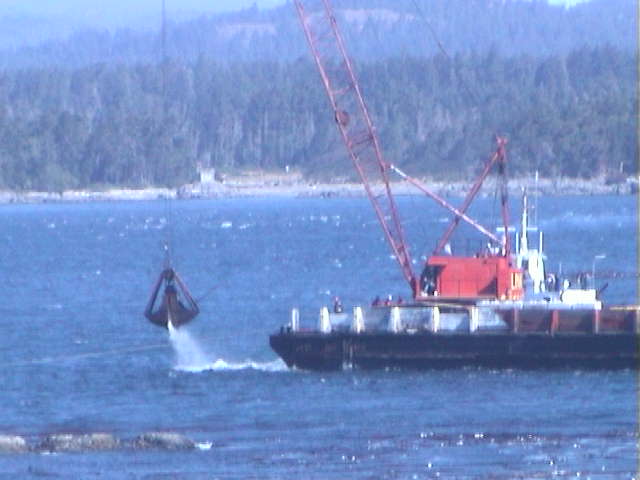 Dredging the overburden for the tidal energy installation.
Dredging the overburden for the tidal energy installation.
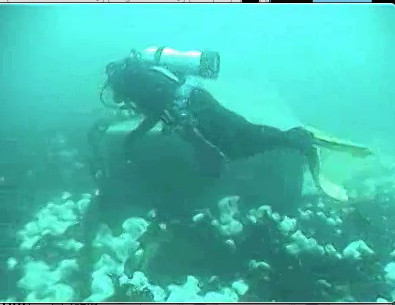 Installation of the Anchors for Drilling for the Tidal Current Energy Project
Installation of the Anchors for Drilling for the Tidal Current Energy Project
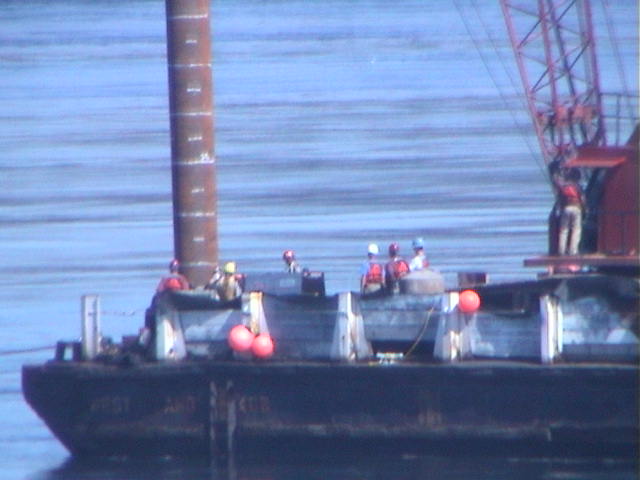 Drilling for the Piling Installation
Drilling for the Piling Installation
Drilling Problems encountered in installation of the tidal current energy Piling
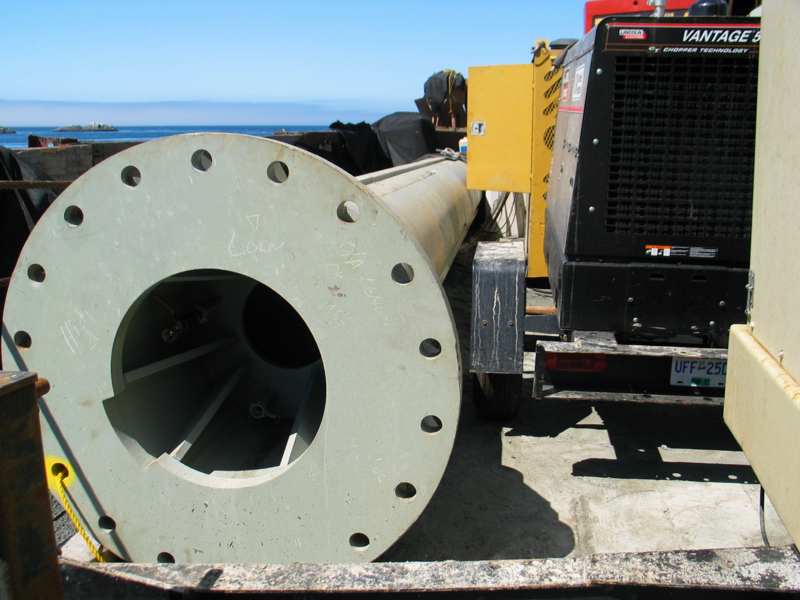 Installation of bottom part of the piling
Installation of bottom part of the piling
Installation of upper part of the piling
Laying of the cable to shore Aug.20-22, 2006
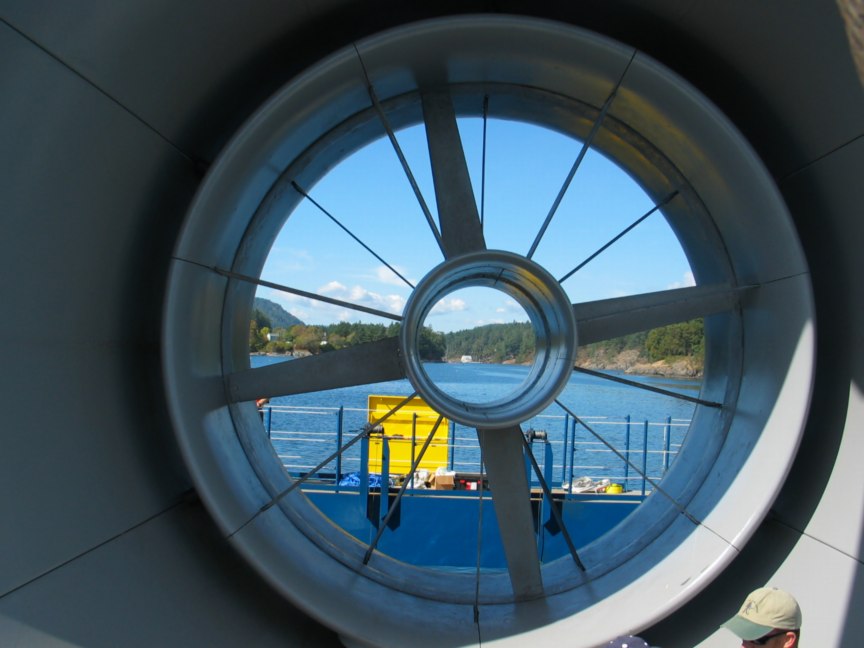 Testing of the Turbine in Pedder Bay
Testing of the Turbine in Pedder Bay
Installation of the turbine Sept. 27, 2006
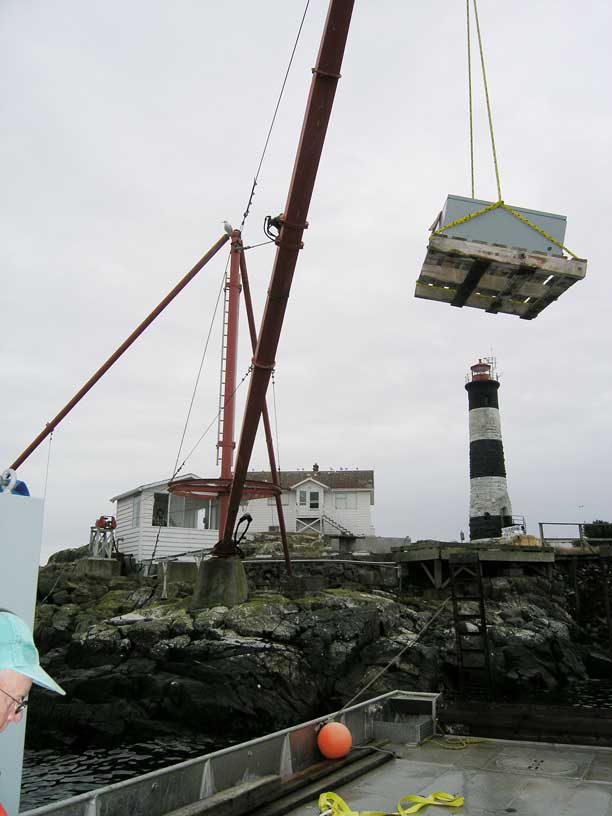 Installation of the turbine control unit Sept 2006
Installation of the turbine control unit Sept 2006
 PM Stephen Harper visits Race Rocks for an “ecoenergy announcement” Jan 19, 2007
PM Stephen Harper visits Race Rocks for an “ecoenergy announcement” Jan 19, 2007
Video on the Pearson College, EnCana, Clean Current Tidal Power Demonstration Project at Race Rocks
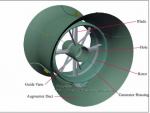 Presentation at the European Commission Coordinated Action on Ocean Energy (CA-OE)Workshop on Environmental, Economics, Development Policy, and Promotion of Opportunities, Copenhagen, Denmark 26-27 April 2007
Presentation at the European Commission Coordinated Action on Ocean Energy (CA-OE)Workshop on Environmental, Economics, Development Policy, and Promotion of Opportunities, Copenhagen, Denmark 26-27 April 2007
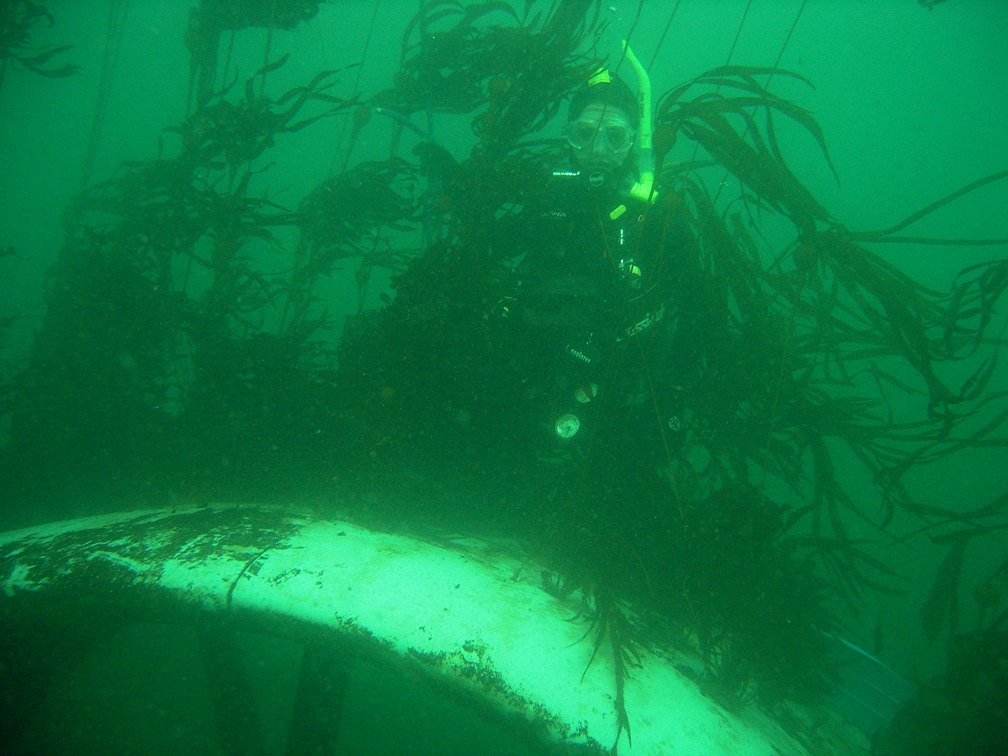 6 months of growth on the Tidal Current turbine April 2007
6 months of growth on the Tidal Current turbine April 2007
Connor Scheu and Wouter Zwart April 2, 2009 the outputs of energy from the system.
April, 2007.The tidal energy turbine is raised to change the bearings which had been deteriorating faster than expected.
 Redeployment of the Tidal Energy Turbine October 2008
Redeployment of the Tidal Energy Turbine October 2008
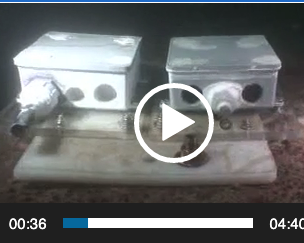 Underwater materials performance testing/fouling 2008
Underwater materials performance testing/fouling 2008
Pandion haliaetus: Osprey—The Race Rocks Taxonomy
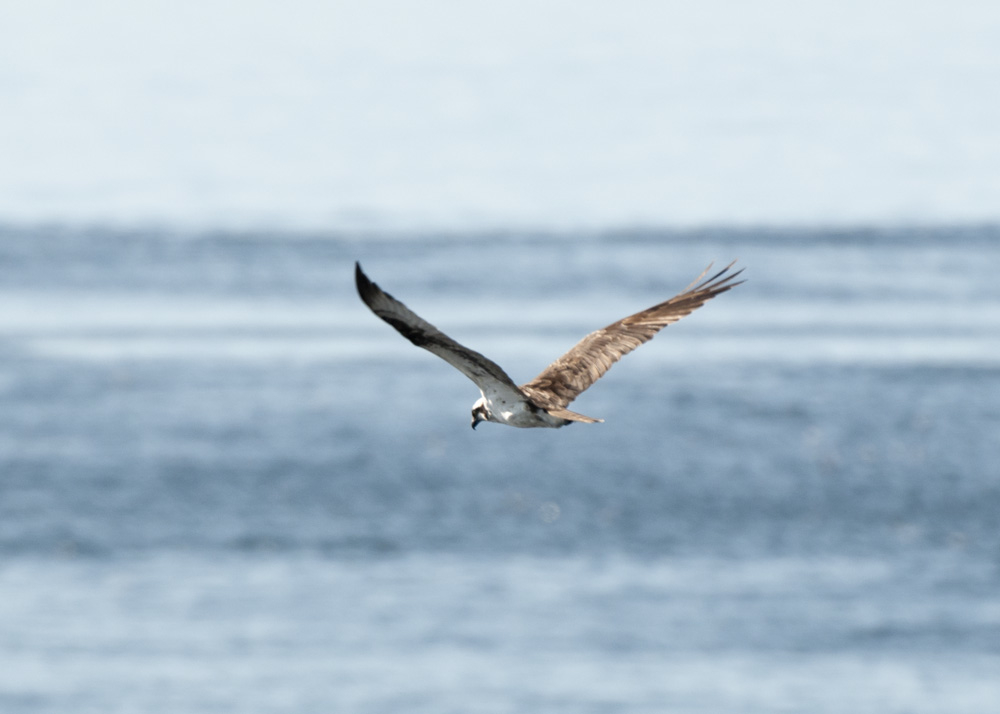
This is the first image taken of this species at Race Rocks. Ryan states: “While counting marine mammals from the lighthouse I noticed the sea gulls take flight similar to a bald eagle response. I then saw this osprey flying SE over Great Race about level with the top of the tower. The next day I observed a pair of ospreys hunting in the shallows West of Pedder Bay Marina.”.We have seen ospreys previously in Pedder bay, where a pair had a nest up until the early-1980’s.
| Image by Ryan Murphy |
| Other Members of the Class Aves at Race Rocks |
and Image File |
 The Race Rocks taxonomy is a collaborative venture originally started with the Biology and Environmental Systems students of Lester Pearson College UWC. It now also has contributions added by Faculty, Staff, Volunteers and Observers on the remote control webcams. The Race Rocks taxonomy is a collaborative venture originally started with the Biology and Environmental Systems students of Lester Pearson College UWC. It now also has contributions added by Faculty, Staff, Volunteers and Observers on the remote control webcams.
Ryan Murphy |

